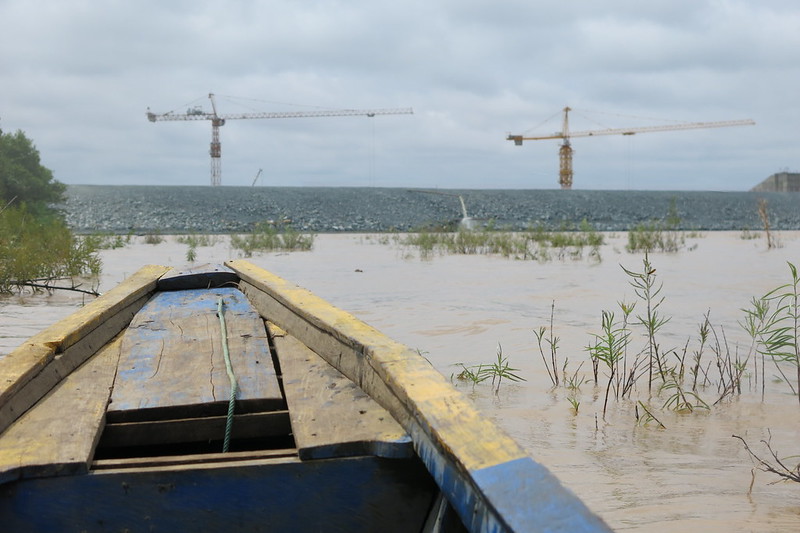Unknown to many Cambodians, severe damage that may affect the whole country is currently occurring. This is being caused by just one dam, the Lower Sesan 2.
According to one survey, the average Cambodian consumes 63.95 kg of fish per year, of which 40.3 kg is freshwater fish. The paper “Trading-Off Fish Biodiversity, Food security, and Hydropower in the Mekong River Basin,” published in the 2012 Proceedings of the National Academy of Sciences of the United States of America, predicts that fish resources will be reduced by 9.3 percent in the Lower Mekong River Basin due to the construction of the Lower Sesan 2.
The dam is being built on the Sesan River, one of the tributaries of the Mekong. However, the construction site is a mere 1.5 km from the confluence of the Sesan and Srepok rivers. The construction site is also only 25 km from the confluence of the Sekong and Mekong rivers. In short, the dam will impact four rivers.
The fish run on the Srepok and Sesan rivers, seen in May and June, is thought to be associated with spawning behavior. According to local residents, however, the annual fish run was almost totally absent from both rivers in May last year, possible because the Lower Sesan 2 construction has already diverted the flow of the Sesan.
When we visited Ratanakiri province in September last year, a man living in Kon Mom district, said of the Srepok River: “Until now, if we placed our nets in the morning, there would be fish caught by the evening. About 5 kg would be caught at one time, but now it is only half that.”
Another man living in Lumphat district told us that Mekong River migratory fish that are usually seen in May did not come up the Srepok River. “From around May right up to now, it has been very hard to live [as there are no fish to be caught],” he said.
It appears that the hydropower company that operates the Lower Sesan 2 plans to construct a fish pass, but its effectiveness is doubtful. Even if fish are able to swim upstream and access the spawning ground, some newly-hatched fry are unable to swim by themselves, and are carried by the flow of the river to downstream habitats. The huge artificial reservoirs will hinder the movement of the fry. Dam reservoirs destroy shallow areas, sandy beaches and rapids, which form the spawning grounds and habitats for fish growth.
Furthermore, for more than 200 species of fish that inhabit the Sesan, Sekong and Srepok rivers, the places where the fish live and spawn during their lifetimes have not been carefully studied. Fish born in the region may be migrating through the Tonle Sap lake. If so, it is possible that the amount of fish caught on lake may decline.
It has been reported that 40 percent of the Lower Sesan 2’s construction is done. The survival of fish is already being threatened by dam construction in the upper reaches of the Mekong River and its tributaries, and by the two mainstream dams being built in Laos (the Xayaburi and Don Sahong). The Lower Sesan 2 will further accelerate this downward spiral. The dam will not only block the flow of water but also sediment, and there is a concern that the dam’s huge reservoir will reduce the flow of fertile soil to the Tonle Sap lake and Vietnam’s Mekong Delta. Almost nothing is known about the implications of this.
We understand that the most important local issue when it comes to the Lower Sesan 2 is the relocation of local communities that would be inundated, and the recovery of their livelihoods. But while the lives of around 5,000 indigenous ethnic minorities will be adversely affected, the dam’s overall impact is likely to be far greater.
Local residents that will be affected upstream from the Lower Sesan 2 construction, mostly in Ratanakkiri province, are thought to number around 78,000 people. Also, as many as 1.2 million people who may be engaged in the fishing industry in the area surrounding the Tonle Sap lake will be directly affected. If there are serious impacts on the lives of these people, who is going to take care of them? Who is going to provide the cheap and high-quality protein that will substitute natural fish? Will the organizations that are funding the dam -- Royal Group, China’s Hydrolancang International Energy, Chinese banks and Vietnam’s EVN International Joint Stock Company -- be able to do this?
The Cambodian government and the implementing organizations should pay attention to the concerns of the people who live both upstream and downstream from the Lower Sesan 2 -- especially with the food security issue in mind.

The temporary rock-filled embankment of the Lower Sesan 2 Dam in Stung Treng Province of north-eastern Cambodia (file photo)
Yuka Kiguchi is the director of Mekong Watch.
Note: This article was first published on the Cambodia Daily on 22 June 2016
Prachatai English is an independent, non-profit news outlet committed to covering underreported issues in Thailand, especially about democratization and human rights, despite pressure from the authorities. Your support will ensure that we stay a professional media source and be able to meet the challenges and deliver in-depth reporting.
• Simple steps to support Prachatai English
1. Bank transfer to account “โครงการหนังสือพิมพ์อินเทอร์เน็ต ประชาไท” or “Prachatai Online Newspaper” 091-0-21689-4, Krungthai Bank
2. Or, Transfer money via Paypal, to e-mail address: [email protected], please leave a comment on the transaction as “For Prachatai English”
